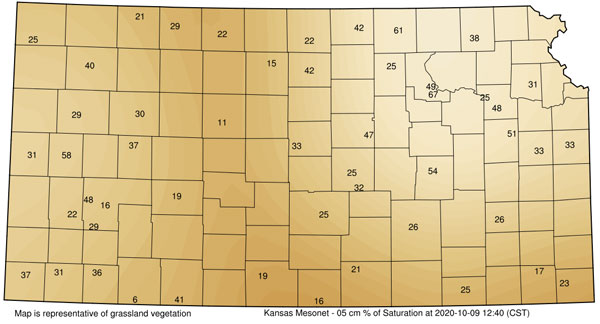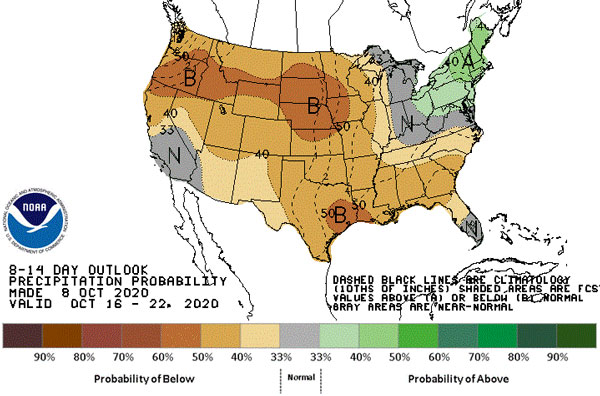The dry pattern that dominated across Kansas in September has continued into October (Figure 1). In the majority of the wheat growing regions, namely central and western Kansas, warmer-than-normal temperatures and windy conditions worsened this lack of precipitation. Consequently, topsoil moisture (2 inches) is low across Kansas (Figure 2).

Figure 1. Total cumulative precipitation for the period between September 30 and October 6, 2020. Map by K-State Weather Data Library.

Figure 2. Percent saturation at 5 cm (2 inches) as of October 9, 2020. Map by the Kansas Mesonet.
Weather Forecast
The weekly quantitative precipitation forecast for Kansas indicates that there is little probability of precipitation for the next seven days. Highest amounts are only a tenth of an inch in the north central portion of the state (Figure 3). The 8- to 14-day (Figure 4) is also unfavorable. While the possibility of some rain still exists, it is unlikely to be sufficient to relieve the current dryness.

Figure 3. Weekly precipitation forecast as of October 9, 2020 by the National Weather Service Weather Prediction Center (NOAA). Precipitation probabilities in Kansas for the next 7 days range from 0.00 to 0.10 inches.

Figure 4. The 8- to 14-day precipitation forecast as of October 9, 2020 by the National Weather Service Weather Prediction Center (NOAA). Precipitation probabilities in Kansas for the next 7 days range from 0.00 to 0.10 inches.
Wait for rain or “dust the crop in”?
The current wheat-planted acreage in Kansas, according to the USDA-NASS crop progress report, was 56% as of October 5, 2020. This is ahead of the 5-year average of 41%, likely due to an early harvest of summer crops. With less than 50% of the winter wheat area still to be planted and 70% of the crop yet to emerge, the biggest question in growers’ minds at the moment is: Should I “dust the crop in” or should I wait for rain?
It is difficult to reach a definitive answer to this question, and each grower must consider his or her own situation to take this decision. Advantages of “dusting the crop in” now and waiting for rain include a good seed distribution usually attained in dry soils, as well as the opportunity to plant a large number of acres before it rains. However, if no rain occurs in the near future, the crop might not emerge until it rains later in the fall or even winter, delaying the “effective planting date” to whenever the rain actually occurs. Thus, growers should treat these fields as if they were sowing late, where increases in seeding rate as well as in-furrow starter fertilizer are recommended. These might also be situations in which seed treatments can be beneficial, as the seeds will be out exposed to weather in the fields for several days. The worst case scenario would include planting into a limited amount of moisture, just enough for emergence of some plants but not enough to maintain these seedlings after they emerge. This situation can result in uneven stands and high within-field stand variability (Figure 5), or even crop failure. Thus, if good moisture cannot be reached in about the top 1.5-2 inches of soil, growers would likely be better off sowing it shallower and waiting for rain.
Otherwise, in central, south central, and southeast Kansas, growers can still wait for a firmer rain forecast to plant their wheat, as these regions are still within the optimum sowing window. This might actually be a good option for growers who can plant all of their remaining acres within a two or three-day timeframe, in case a stronger chance of rain appears in the forecast. The disadvantage of waiting is that, if the fields do not get planted before a potential precipitation event, moist soils can delay sowing dates.
For more information on planting wheat into dry soils, please see a previous eUpdate article from October 2, 2020: Considerations when planting wheat into dry soils

Figure 5. Uneven wheat stands resultant from sowing into dry soils. Photo by Romulo Lollato, K-State Research and Extension.
Romulo Lollato, Wheat and Forages Specialist
lollato@ksu.edu
Mary Knapp, Weather Data Library
mknapp@ksu.edu
Tags: wheat planting conditions